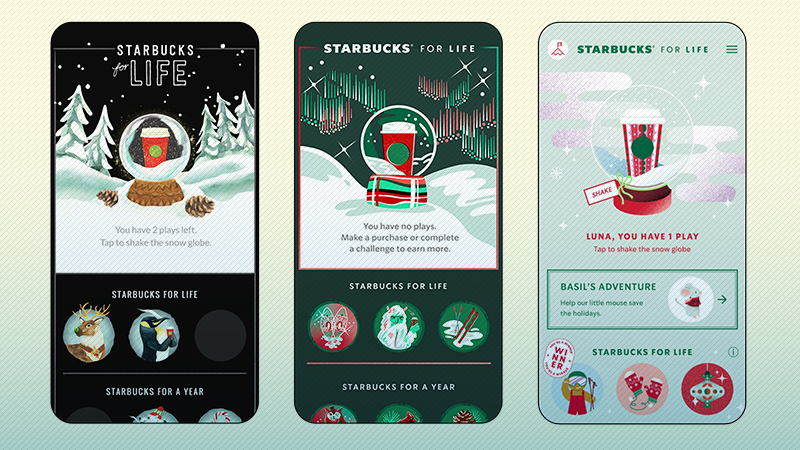Every year, the holiday season brings the same question for brands:
“How do we show up meaningfully — without feeling like just another ad?”
People are overwhelmed with campaigns in December.
Discounts, giveaways, endless “Holiday Special” banners.
Most brands try harder, but only a few connect deeper.

And interestingly, the brands that do connect often rely on something very simple:
They give people a moment of joy — not just a message.
This is where gamification begins to shine.
Not as a gimmick.
Not as a “play this to win that.”
But as a shared experience that feels human.

Gamification is about sharing excitement and happy moments between brand and customers (Case Study of Adidas and Octokit: Run To The Moon 2025 Campaign)
Why Gamification Works During the Holidays
The holidays are emotional.
Warm. Soft. A little nostalgic.
People naturally want to share, gift, remember and celebrate.
Gamification fits into this season because it fuels exactly those behaviors:
| Human Desire | Holiday Expression | How Gamification Supports It |
| Feeling of belonging | “We’re celebrating together” | Shared participation and community challenges |
| Expression and identity | Decorating, gifting, storytelling | Personalized game choices and outcomes |
| Joy in small surprises | Gifts, advent calendars, tiny moments | Rewards, unlocks, progression feedback |
| Reflection and meaning | Looking back at a year lived | Narrative and emotional touchpoints |
So the question isn’t “How do we make a game?”
It’s “How do we create a moment that feels like joy?”

Studies reveal that gamification taps into core human emotions and behaviors — even in ordinary situations. When paired with the sentiment of the holiday season, it becomes a meaningful way for brands to say thank you and create experiences that genuinely satisfy customer desires.
Gamification for Brands Is Not Really About Games
It’s about designing a micro-experience that makes someone feel:
- “That was fun.”
- “That was thoughtful.”
- “This brand gets me.”
A good holiday gamified experience isn’t loud or flashy.
It’s warm. Playful. Light.
It doesn’t interrupt.
It invites.
It says:
“Hey, take a small moment for yourself.
Enjoy this.
You deserve something delightful today.”
And people respond — not because they were told to, but because it felt right.
For instance, every year, Starbucks becomes a masterclass in how to blend holiday spirit, customer appreciation, and gamification — all while gently nudging people toward the Starbucks App.

Their most iconic campaign is “Starbucks for Life”, launched every Christmas season
The Psychology Behind It (Simple, but Deep)
Gamification during the holidays works because it activates:
- Emotional Memory
People remember how something made them feel — not just what it offered. - Effort Justification
When users interact — even lightly — the experience feels more valuable. - Shared Identity
If the experience creates something personal, people naturally share it.
This is where engagement becomes organic, not forced.

So Where Does Octokit Fit Into This?
Not as “the tool to make games fast” — even though yes, it can create a brand game in 15 minutes.

But more importantly:
Octokit lets marketers create holiday experiences without overcomplicating things.
- No heavy production cycle
- No 2-month development timeline
- No stress
- Easy application
- Various templates

Brand and marketers can just:
- Choose and change to brand’s interactive format
- Wrap it in your seasonal story by, for this season, Christmas event of course
- Launch
- Let people enjoy
- Especially, winners can receive gifts, vouchers from brand thanks to Octokit’s rewards setup

Octokit provides template variations across genres and campaign objectives, making it easy to create experiences for personal audiences, brand promotions, community activations, and major event engagements
A Real Example of This Working in the Wild
Mana Mart – Malaysia
When Mana Mart introduced Malaysia’s first halal tanghulu product, they didn’t rely on heavy promotion or sales pushes.
Instead, they created a simple, adorable mini-game where players stack the tanghulu in a stable stand — a small, joyful moment tied to the product experience.

Mini-game scenes of Mana Mart on Octokit
Results
- Thousands of plays during the campaign period: 17,000 play sessions and attracting more than 1,900 unique users. Customers brought friends back to try and beat their scores.
- Strong in-store booth traffic and sampling engagement. Within the first month, the halal tanghulu products had more than 100,000 units sold.

- The product launch felt fun, not “marketed”. However, Mana Mart has successfully collected over 3000 new profiles online and offline.
Without a doubt, Mana Mart has publicly shared their experience on Product Hunt, noting how refreshing it was to create engagement without needing a technical team, and that the campaign felt “light, warm, and genuinely delightful to customers.”

A launch rooted in joy — not pressure — built real interest.
The Takeaway: Why This Matters Now
Holiday gamification isn’t just “a fun idea.”
It’s becoming a core strategy because the numbers back it up:
- The global gamification market is projected to reach $48.7 billion by 2029, growing at nearly 27% annually.
- Campaigns that use interactive elements see 2–5x higher engagement than traditional posts.
- Brands that incorporate playful micro-interactions during peak seasons report up to 30% more repeat interaction — not just views, but returns.
- And importantly: people share experiences, not ads — making word-of-mouth scale naturally.
This is especially true during the holidays, when emotional receptivity is already high.
A small, meaningful, joyful moment travels further than any discount code ever will.
We are moving into a marketing era where:
- Attention is earned through delight, not volume.
- Brand love is built through participation, not persuasion.
- Memorability comes from feeling, not messaging.
Gamification is not replacing storytelling —
it is becoming the medium through which storytelling is felt.
And as more brands shift from campaigns to experiences,
from announcements to shared moments,
gamification is increasingly becoming the foundation for how they connect — not just during holidays, but all year long.










